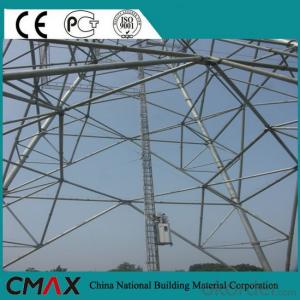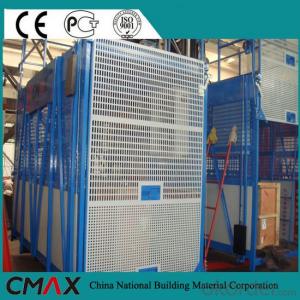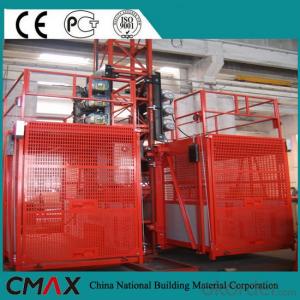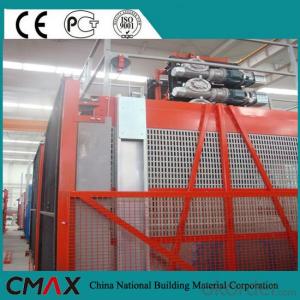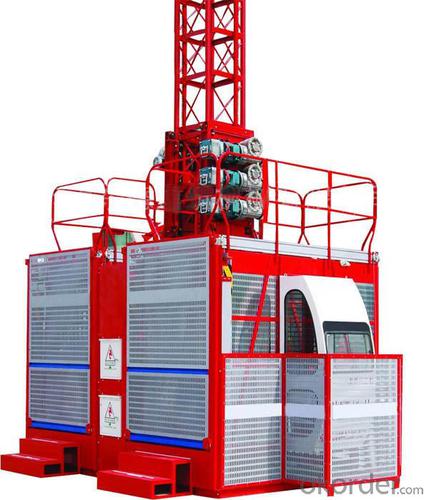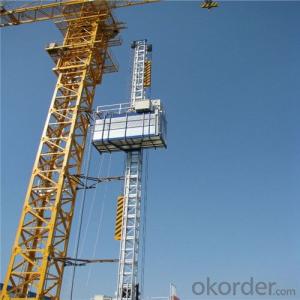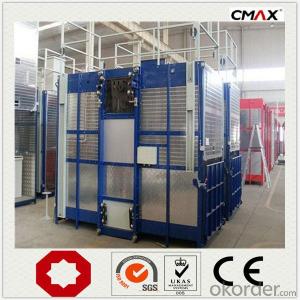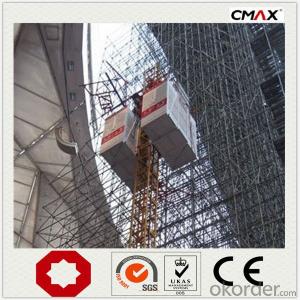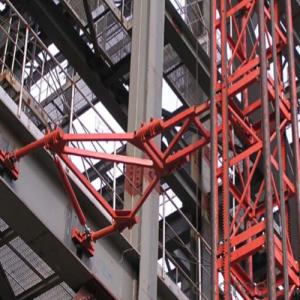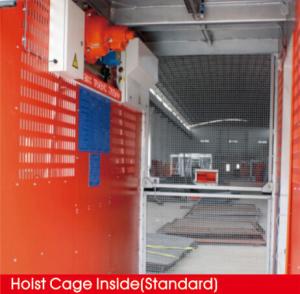Construction Hoist SCD320 Counterweight Elevator
- Loading Port:
- China main port
- Payment Terms:
- TT or LC
- Min Order Qty:
- 1 unit
- Supply Capability:
- 30 unit/month
OKorder Service Pledge
OKorder Financial Service
You Might Also Like
Structure of Construction Hoist Description
1.Feature: Construction Hoist
2.Payload(kg):3200
3.Lifting Speed(m/min):33
4.Motor Power(kw): 2*15
5.Safety Device: SAJ50-1.2
6.Cage: Single
7.Counterweight: Yes
8.Certification: CE,ISO
9.Place of Origin: China(Mainland)
10.Model Number: Type:SCD320
Packaging & Delivery of Construction Hoist
Packaging Detail: Nude package Delivery Detail: 25-30days
Main Parts of Construction Hoist
● The gearing adopts imported bearing, enameled cable, and oil seal.
● The electric parts adopt products from world renowned manufactures such as Schneider, Siemens, and LG.
● The racks and pinion adopts special material and heat-treatment technique, which prolong the life of these parts.
● The steel structure uses quality steel from famous domestic manufactures.
● The surface of the structure can apply paint-spray, parkerozing baking finish or hot galvanizing processing according
to users requirements,
● The cage can be produced and decorated by aluminum molded board, punched-plate or figured aluminm board.
Construction Hoist Specifiction
Single cage High speed
Model | Speed(m/min) | Deadweight(kg) | Motor(KW) | Counterweight | Specification(L×W×H)(m) |
SC100G | 96 | 1000 | 3×22 | No | 2.5×1.3×2.5 |
SC120G | 96 | 1200 | 3×22 | NO | 3.0×1.3×2.5 |
SCD200G | 96 | 2000 | 3×15 | Have | 3.2×1.5×2.5 |
SC200G | 96 | 2250 | 3×22 | No | 3.2×1.5×2.5 |
SC270GS | 96 | 2700 | 3×22 | No | 3.8×1.5×2.5 |
SCD270G | 96 | 2700 | 3×18.5 | Have | 3.8×1.5×2.5 |
SCD300G | 96 | 3000 | 3×22 | Have | 4.0×1.5×2.5 |
SCD320GS | 96 | 3200 | 3×22 | Have | 4.2×1.5×2.5 |
Single cage Medium speed
SC100GZ | 63 | 1000 | 3×15 | No | 2.5×1.3×2.5 |
SC120GZ | 63 | 1200 | 3×15 | No | 3.0×1.3×2.5 |
SCD200GZ | 63 | 2000 | 2×15 | Have | 3.0×1.3×2.5 |
SC200GZ | 63 | 2000 | 3×18.5 | No | 3.0×1.3×2.5 |
SC225GZ | 63 | 2250 | 2×18.5 | No | 3.2×1.5×2.5 |
SC225GZ | 63 | 2250 | 3×18.5 | Have | 3.6×1.5×2.5 |
SCD250GZ | 63 | 2500 | 2×18.5 | Have | 3.6×1.5×2.5 |
SC250GZ | 63 | 2500 | 3×18.5 | Have | 3.8×1.5×2.5 |
SCD270GZ | 63 | 2700 | 2×18.5 | Have | 3.8×1.5×2.5 |
SC270GZ | 63 | 2700 | 3×22 | NO | 4.0×1.5×2.5 |
SCD300GZ | 63 | 3000 | 3×15 | Have | 4.0×1.5×2.5 |
SCD320GZ | 63 | 3200 | 3×15 | Have | 4.2×1.5×2.5 |
Single cage standard speed
SC100TD | 36 | 1000 | 2×11 | NO | 2.5×1.3×2.5 |
SC120TD | 36 | 1200 | 2×11 | NO | 3.0×1.3×2.5 |
SC200TD | 36 | 2000 | 3×11 | NO | 3.0×1.3×2.5 |
SCD200TD | 36 | 2000 | 2×11 | Have | 3.2×1.5×2.5 |
SC270TD | 36 | 2700 | 3×15 | NO | 3.6×1.5×2.5 |
SCD270TD | 36 | 2700 | 2×11 | Have | 3.8×1.5×2.5 |
SC320TD | 36 | 3200 | 3×18.5 | NO | 4.0×1.5×2.5 |
SCD320TD | 36 | 3200 | 2×11 | Have | 4.2×1.5×2.5 |
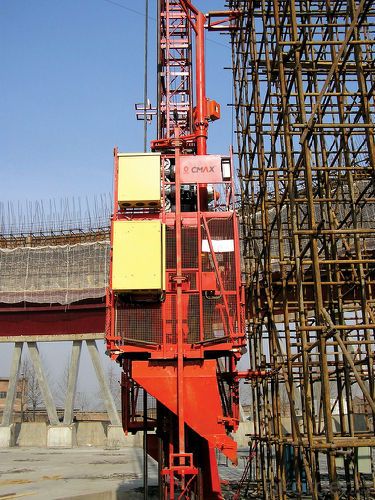
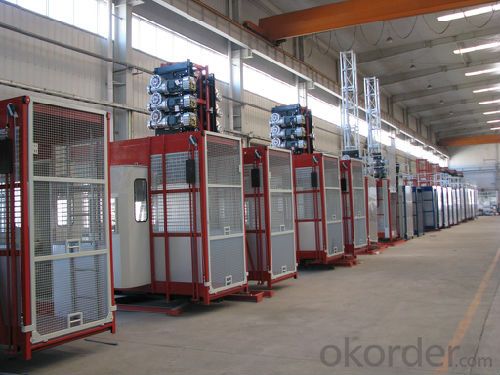

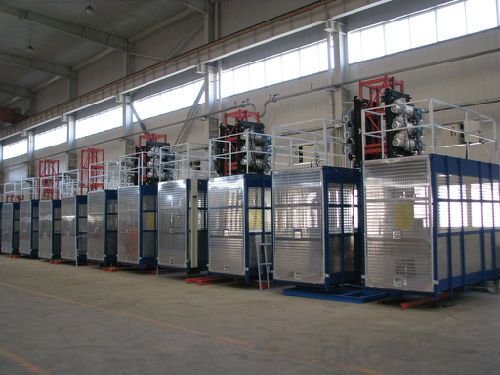
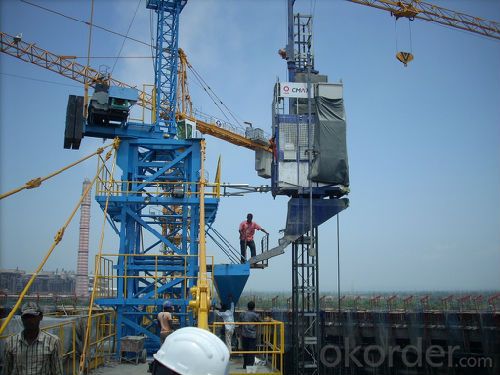
FAQ of Construction Hoist
Q: What is the building hoist main purpose?
A: Building hoist equipped with double or single cabin to transport the materials and labors up and down. It's the ideal
construction equipment for vertical transportation in the field of construction.
Q: What is the main structure of building hoist?
A: The P/M construction hoist mainly contains metal structure, driving system, electrical control system, cable guide &
protection system, electrical top crane and safety device.
Q: What is the meaning of the building hoist’s code?
A: Take SC200/200 for example: “SC” stands for rack and pinion hoist, “200/200” stands for double cage and capacity
is 2 tons per cage. “SC200” stands for single cage and capacity is 2 tons.
Q: What is the dimension of the cage?
A: Normally the cage dimension is 3X1.5X2.5M (L/W/H) for 2t type hoist. Details should be checked according to our
quotation sheet. Also, the size can be customized according to the factual site condition. There are two doors (entrance
& exit doors) for each cage, It can be produced as up & down sliding or ramping model for safety and convenience.
- Q: Is it possible to use a lifting device to assist in lifting an individual who is too tall for one person to lift safely?
- <p>Yes, you can use a lifting device to assist in lifting someone who is too tall for you to lift alone. These devices are designed to help in safely moving individuals who are heavier or taller than can be managed without assistance. It's important to ensure that the lifting device is appropriate for the person's weight and height, and that it is used correctly to avoid injury. Always follow the manufacturer's instructions and safety guidelines when using such equipment.</p>
- Q: This question asks about the procedures and practices for regularly maintaining and inspecting a building hoist to ensure its safe and efficient operation.
- <p>Regular maintenance and inspection of a building hoist are crucial for safety and efficiency. It involves daily checks before use, including visual inspections for any visible damage, proper functioning of safety devices, and ensuring the hoist is clean and free of debris. Weekly inspections should focus on the mechanical components, such as gears, cables, and brakes, and checking for any unusual noises or vibrations. Monthly inspections may include more in-depth checks of the electrical systems and the structural integrity of the hoist. Annual inspections typically involve a thorough examination by a certified professional, who will assess the overall condition and safety of the hoist, ensuring it complies with all relevant safety standards. Always follow the manufacturer's guidelines and local regulations for maintenance and inspection schedules.</p>
- Q: What's going on with the decline in construction lift
- Check to see if there is any problem with holding the brake. There is no problem with the contactless contactor, which is the most common cause of the vehicle. Normal contactor will rebound at the moment of you to stop operation, adhesion would be stuck there for a few seconds and then bounce back, in a few seconds the brake coil is charged, the brake is still in open state, but the motor has stopped working, so will decline, it's adhesion change the same contactor change.
- Q: This question asks about the different types of hydraulic cylinders that are utilized in lifting equipment.
- <p>Hydraulic cylinders used in lifting equipment can be categorized into several types based on their design and application. The main types include: single-acting cylinders, which have one port for fluid and rely on the load or a spring to return; double-acting cylinders, which have ports on both ends and can extend and retract through fluid pressure; telescopic cylinders, which consist of multiple stages that can extend sequentially for greater reach; and rotary hydraulic cylinders, which provide a combination of linear and rotary motion. Each type is chosen based on the specific requirements of the lifting task, such as the need for speed, force, and control.</p>
- Q: Is it possible to repair or replace a hydraulic pump used in a building hoist system?
- <p>Yes, a hydraulic pump used in a building hoist can be repaired or replaced. If the pump is damaged or worn out, it can be serviced or repaired by professionals who specialize in hydraulic systems. If the damage is beyond repair, a new pump can be sourced and installed to ensure the hoist operates safely and efficiently. Regular maintenance and inspection are crucial to prevent major issues and to extend the life of the hydraulic pump.</p>
- Q: Is it possible to replace a lifting rope in a construction hoist with a regular rope?
- <p>No, a regular rope should not be used as a substitute for a lifting rope in a building hoist. Lifting ropes are specifically designed for heavy-duty lifting and have safety standards to ensure they can withstand the weight and stress. Regular ropes lack these safety features and can break under heavy loads, leading to accidents. Always use the appropriate lifting equipment as specified by safety regulations and the manufacturer's guidelines.</p>
- Q: This question asks about the various mechanisms that enable lifting in building hoists, which are essential for construction projects.
- <p>Building hoists utilize several types of lifting mechanisms to efficiently move materials and personnel. The most common types include: 1. Geared Hoists, which use a system of gears to lift and lower loads. 2. Electric Chain Hoists, powered by electric motors and are suitable for heavier loads. 3. Air Hoists, which use compressed air to generate lifting force and are ideal for environments where electricity is a hazard. 4. Manual Chain Hoists, operated by hand and best for lighter loads. 5. Electric Wire Rope Hoists, which offer high lifting capacities and are controlled by electric motors. 6. Pneumatic Hoists, similar to air hoists but use pneumatic power for lifting. Each type has specific applications and safety considerations, making them suitable for different construction needs.</p>
- Q: This question asks about the precautions and safety protocols that should be followed when using lifting equipment in construction projects.
- <p>Safety measures for using lifting equipment in construction work include regular inspections and maintenance of the equipment, ensuring all safety features are in place and functioning correctly. Operators must be trained and certified for the specific type of lifting equipment they are using. Load limits should never be exceeded, and all loads must be secured properly. Safe operating procedures should be followed, such as not lifting loads over people and maintaining a safe distance from power lines. Personal protective equipment (PPE) must be worn by operators and workers in the vicinity. Emergency procedures should be established and communicated to all workers. Regular safety briefings and training sessions should be conducted to keep safety at the forefront of all operations.</p>
- Q: Is it possible to utilize a building hoist for the transportation of heavy objects?
- <p>Yes, building hoists are specifically designed to move heavy objects vertically within a construction site. They are used to lift and lower materials such as concrete, bricks, and other construction supplies. Building hoists are equipped with strong cables and a robust mechanism to handle significant weight, making them ideal for heavy-duty lifting tasks in construction projects. However, it's crucial to ensure that the hoist is operated within its weight capacity and safety guidelines are strictly followed to prevent accidents.</p>
- Q: This question asks if it is permissible to use a building hoist for the purpose of lifting people.
- <p>No, a building hoist should not be used for lifting people. Building hoists are designed for the transportation of materials and equipment during construction, not for carrying personnel. Using a building hoist to lift people is dangerous and against safety regulations. It poses significant risks, including falls and equipment malfunctions, which can lead to serious injuries or fatalities. Always use designated personnel lifts or other safe methods for moving people in construction settings.</p>
Send your message to us
Construction Hoist SCD320 Counterweight Elevator
- Loading Port:
- China main port
- Payment Terms:
- TT or LC
- Min Order Qty:
- 1 unit
- Supply Capability:
- 30 unit/month
OKorder Service Pledge
OKorder Financial Service
Similar products
Hot products
Hot Searches
Related keywords

